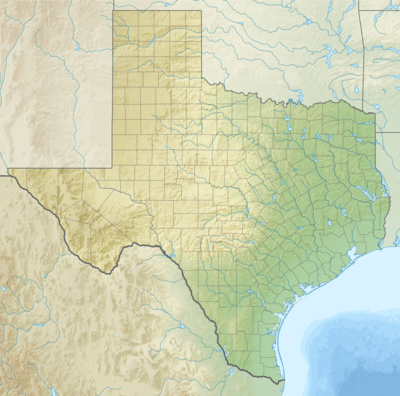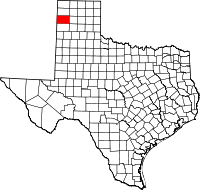Tascosa, Texas
| Tascosa, Texas | |
|---|---|
| Ghost Town | |
| Nickname(s): Old Tascosa | |
| Motto(s): Cowboy Capital of the Plains | |
 Location within Texas | |
| Coordinates: 35°31′52″N 102°15′20″W / 35.53111°N 102.25556°WCoordinates: 35°31′52″N 102°15′20″W / 35.53111°N 102.25556°W | |
| Country | United States |
| State | Texas |
| County | Oldham |
| Plaza Atascosa | 1876 |
| Elevation | 3,192 ft (973 m) |
| Time zone | UTC-6 (Central (CST)) |
| • Summer (DST) | UTC-5 (MDT) |
| GNIS feature ID | 2646624 |
Tascosa, sometimes called Old Tascosa, is the former capital of ten counties in the Texas Panhandle. The town emerged briefly in the 1880s as an economic rival of Dodge City, Kansas. Located in Oldham County northwest of Amarillo, Texas, Tascosa is now a ghost town.
Origin
Tascosa, named for a nearby creek, was rooted in a local crossing of the Canadian River which cowboys passed on their way to the railhead and cattle markets in Dodge City. The role of Tascosa was comparable as a regional center to that of Mobeetie in Wheeler County further east. Tascosa was a town of tents and adobe, with a stone court house erected in 1884 at a cost of $18,000. It reached its peak in 1888 with cattle, farming, dairying, and general merchandising.[1]
Tascosa served the cattle ranches for a hundred miles in every direction. It was a popular rendezvous for cows hands who frequented bars and dance halls after hard labor on the sage brush and sands of the Canadian River Valley.[1] With its gambling houses and brothels, Tascosa was visited by such Old West characters as Billy the Kid and Pat Garrett. Despite a reputation for lawlessness and the lack of a church for several years, Tascosa had a considerable element of substantial citizens. The Tascosa Pioneer wrote that the community "is not half so rough as many have been led to believe ... but in general the people of Tascosa and Oldham are whole-hearted, sociable, and exceptionally civil. Law-breaking is the exception and not the rule."[2]
The post office opened on June 24, 1878.[3] By 1880, enough voters were available in Tascosa and Oldham County for purposes of organization of government. Oldham was the second county organized in northwest Texas. Nine other Panhandle counties (Hartley, Dallam, Sherman, Moore, Potter, Randall, Deaf Smith, Parmer, and Castro) were removed from Wheeler County and joined with Oldham for land and judicial purposes. Tascosa hence had a governmental role like that of Mobeetie.[1]
On March 21, 1886, the Tascosa Gunfight led to the deaths of four persons.
Decline
The coming of the Fort Worth and Denver Railway was expected to revitalize Tascosa. However, there were two miles of deep sand between the railroad track and the town. Though the editor of The Tascosa Pioneer believed the citizens could overcome all odds against them, this physical limitation proved insurmountable.[1]
By the 1930s, the town was almost deserted. In 1938, Cal Farley's Boys Ranch was built on the site. The old courthouse (now a museum) and the 1889 schoolhouse are the only buildings from the old town to survive into the 21st century.
Tascosa was the setting for the showdown between Lin McAdams (Jimmy Stewart) and Dutch Henry Brown (Stephen McNally) in the 1950 American western film, Winchester 73.
Climate
According to the Köppen Climate Classification system, Tascosa has a semi-arid climate, abbreviated "BSk" on climate maps.[4]
References
- 1 2 3 4 5 Lester Fields Sheffy, The Life and Times of Timothy Dwight Hobart, 1855-1935: Colonization of West Texas (Canyon, Texas: Panhandle-Plains Historical Society, 1950), pp. 146-148.
- ↑ The Tascosa Pioneer, June 12, 1886.
- ↑ Maverick Town: The Story of Old Tascosa, page 56
- ↑ Climate Summary for Tascosa, Texas
